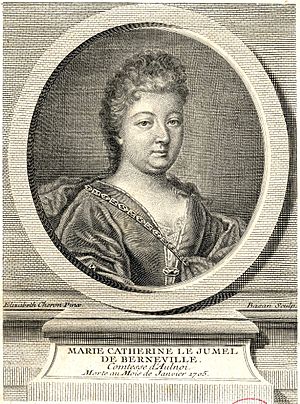Madame d'Aulnoy facts for kids
Quick facts for kids
Madame d'Aulney, Baroness d'Aulnoy
|
|
|---|---|

Marie-Catherine d'Aulnoy
|
|
| Born | Marie-Catherine Le Jumel de Barneville 1650/1651 Barneville-la-Bertran, Normandy, France |
| Died | 4 January 1705 (age 53–55) |
| Occupation | Fairy tale writer, baroness |
| Notable works |
|
| Spouse | François de la Motte, Baron d'Aulnoy |
| Children | 6 |
Marie-Catherine Le Jumel de Barneville, Baroness d'Aulnoy (born around 1650 or 1651, died January 14, 1705) was a famous French writer. She is best known for her literary fairy tales. In fact, she was the first person to use the term contes de fées, which means "fairy tales." This is the name we still use for these stories today.
Contents
Discovering Marie-Catherine d'Aulnoy's Life
Marie-Catherine was born into a noble family in Barneville-la-Bertran, a region in Normandy, France. When she was about 15 years old, her father arranged for her to marry François de la Motte, Baron d'Aulnoy. He was a Parisian nobleman who was 30 years older than her.
Early Challenges and Escapes
Life for Marie-Catherine was not always easy. In 1669, her husband, the Baron d'Aulnoy, faced serious accusations. He was accused of speaking out against the king's taxes. If found guilty, he could have been executed. The baron spent three years in prison before proving his innocence.
During this time, Marie-Catherine also faced danger. A warrant was issued for her arrest. She managed to escape by climbing out a window and hiding in a church. Her mother, who was also involved, fled to England.
A Life of Travel and Writing
After these events, Marie-Catherine might have worked as a spy for France. She may have traveled to places like Holland, Spain, and England. She returned to Paris around 1685.
In Paris, she became a popular host of "salons." These were gatherings in her home where important people, like aristocrats and princes, would meet. They would discuss ideas, literature, and art. Her close friend, Saint-Evremond, often attended these events.
Marie-Catherine d'Aulnoy wrote many books, including novels and collections of stories. She also wrote travel memoirs. These books were based on her supposed journeys through the courts of Madrid and London. Even though some parts of these stories might have been made up, they became very popular.
She gained a reputation as someone who recorded tales from other countries. She was even chosen as a member of the Paduan Accademia dei Ricovrati. There, she was called "Clio," after the muse of history. At that time, the idea of "history" was broader. It included stories that were partly fictional. Later, as history became more strictly documented, some of her accounts were seen as not entirely factual. However, her works were enjoyed as entertainment in France and England.
Her Famous Fairy Tales
Marie-Catherine's most popular works were her fairy tales and adventure stories. These were published in collections like Les Contes des Fées (Tales of Fairies) and Contes Nouveaux, ou Les Fées à la Mode.
Unlike the folk tales collected much later by the Brothers Grimm, d'Aulnoy told her stories in a more conversational style. This was similar to how stories might be shared in the salons she hosted. Many of her tales featured characters like animal brides and grooms. They showed heroines finding love and happiness after overcoming big challenges.
These original stories were not always meant for young children. Many English versions of her tales were changed to be more suitable for a younger audience. Scholars believe that Madame d'Aulnoy knew many traditional folk tales. She likely used these as inspiration for her own unique stories.
Family Life
Madame d'Aulnoy had six children. The money she earned from her writing helped her to raise her three daughters.
Selected Works
Here are some of Marie-Catherine d'Aulnoy's well-known fairy tales:
From Fairy Tales (Les Contes des Fées) (1697)
- Babiole
- Cunning Cinders (Finette Cendron)
- Graciosa and Percinet (Gracieuse et Percinet)
- Princess Mayblossom (La Princesse Printanière)
- Princess Rosette (La Princesse Rosette)
- The Bee and the Orange Tree (L'Orangier et l'Abeille)
- The Benevolent Frog or The Frog and the Lion Fairy (La Grenouille bienfaisante)
- The Blue Bird (L'Oiseau bleu)
- The Dolphin (Le Dauphin)
- The Fortunate One or Felicia and the Pot of Pinks (Fortunée)
- The Imp Prince (Le Prince Lutin)
- The Little Good Mouse (La bonne petite souris)
- The Ram or The Wonderful Sheep (Le Mouton)
- The Story of Pretty Goldilocks or The Beauty with Golden Hair (La Belle aux cheveux d'or)
- The Yellow Dwarf (Le Nain jaune)
- The White Doe or The Hind in the Wood (La Biche au bois)
From New Tales, or Fairies in Fashion (Contes Nouveaux ou Les Fées à la Mode) (1698)
- Belle-Belle (Belle-Belle ou Le Chevalier Fortuné)
- Green Serpent (Serpentin vert)
- The White Cat (La Chatte Blanche)
- The Golden Branch (Le Rameau d'Or)
- The Pigeon and the Dove (Le Pigeon et la Colombe)
- Prince Marcassin (Le Prince Marcassin)
- Princess Belle-Etoile (La Princesse Belle-Étoile)
- The Princess Carpillon (Princesse Carpillon)
See also
 In Spanish: Madame d'Aulnoy para niños
In Spanish: Madame d'Aulnoy para niños

